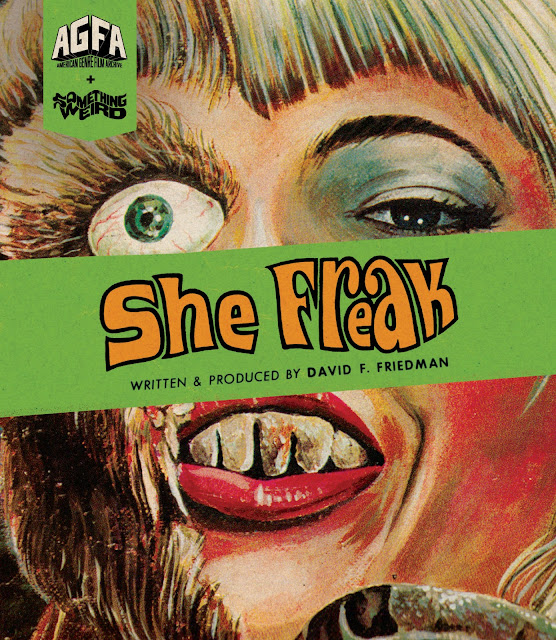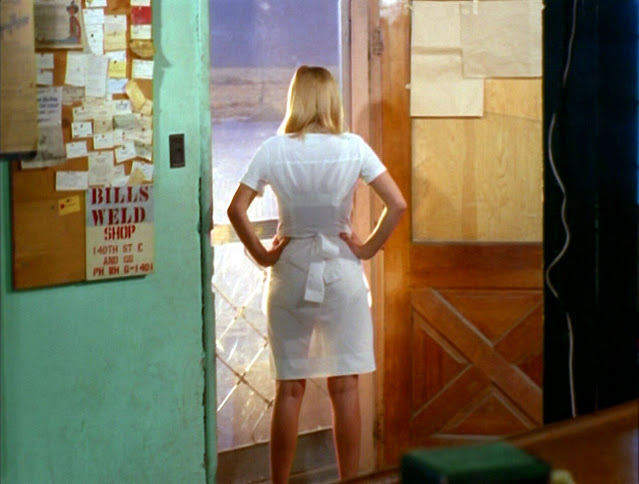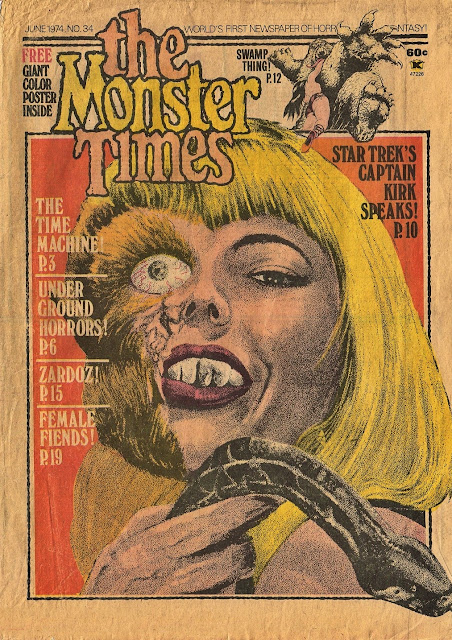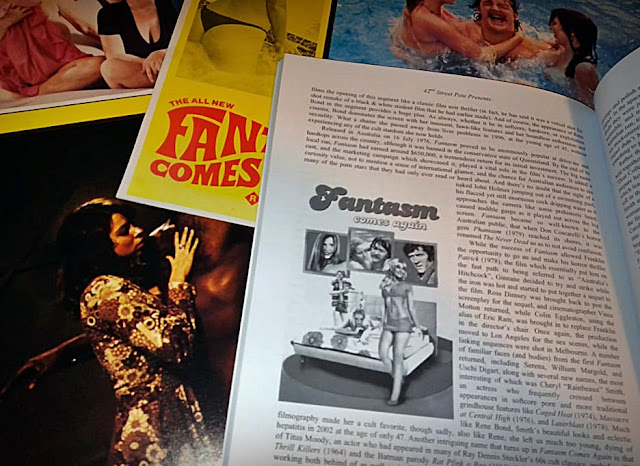I
was truly gutted to hear of the sudden and very unexpected passing of Adam Lee over
the weekend. A local legend on the film collecting scene, Adam's knowledge (and
collection of) vintage Australian VHS tapes was second to none, as was his
overall knowledge of, and passion for, genre cinema. Euro soundtracks were
another big love of his.
I first met Adam back in the mid-90s, when I was
publishing REEL WILD CINEMA! and he was publishing SPASMO. I published one of
Adam's first pieces of writing, a look at Joe D'Amato's sleaze epic BEYOND THE
DARKNESS, in an issue of REEL WILD CINEMA!, and thought it was one of the best
things to ever grace its pages, even though Adam himself was still a little
uncertain of his writing. In more recent years, it was always nice to catch up
with him at a film fair or VHS swap meet, he was always smiling, always
friendly, oftentimes he would sling me a few free old paperbacks that he had
picked up that he thought I might like, or pass on one of the amazing custom CD
soundtracks he would press.
To say I am saddened and in a state of shock is an
understatement. Adam and I had just been talking about some of his upcoming
projects, which sounded very exciting. He was really starting to get into doing
some terrific work, with his excellent VIDEOMANIA zine and massive AUSTRALIAN
VIDEO GUIDE, which he was currently in the process of updating and expanding.
They will likely remain essential works for many years to come.
Much sympathy to Adam's partner Sarah, and all of
his family and friends. Gone much too soon, but was loved and made his mark. Recently,
I had written an introduction for the planned update of his AUSTRALIAN VIDEO
GUIDE, which he had been working feverishly on. I have decided to now publish
the intro that I wrote below, in tribute and memory to Adam.
By John Harrison
One of the benefits of being an eager young film buff
in the mid-seventies was getting to live through several different shifts in
the landscape of home movie viewing. For those lucky enough not to be so old,
the seventies were a much tougher time to see movies, even more so in
Australia, where your choice was limited to what was showing at the cinema or
drive-ins, or what any of the few commercial television stations would choose
to air. Don’t get me wrong, television could still be pretty great back then,
Ivan Hutchinson’s Midday Movie on Channel 7, and the all-night triple-movie
marathons that screened almost every night on Channel 9, gave me a film
education that I wouldn’t trade for anything.
For people who wanted the luxury of reliving a
favourite film whenever the mood struck, the 1960s and 70s did offer the Super
8 home movie digest reels, which would usually edit a feature down to a short
highlights reel and could be often purchased in both sound and silent, not to
mention B&W or colour versions, depending on one’s budget. It should be
noted that the vintage paperback film tie-in was also something of a precursor
to VHS. It provided a way for a fan to relive a favourite film, and of course
the often spectacular and frequently lurid paperback cover art lured you in
just like those wonderfully gaudy VHS covers would a decade later. Film
soundtracks were yet another way to bring the cinematic experience home for you
to enjoy at leisure (and some companies would even release special narrated
soundtracks, retelling the film’s story).
When home video started to really penetrate into the
suburbs of Melbourne around 1982, it was considered something of a status
symbol to have one of those big clunky top-loaders perched on top of your TV
set. Much like colour television when it was first introduced in Australia in
1975, not everyone could afford to jump straight onto the home video bandwagon.
But it took a foothold and started expanding exponentially, and by 1984 if you
didn’t yet have a VHS (or Beta) player to call your own, you at least had one
or two friends who did.
I was still a student at that time, having just
started a tertiary orientation program at CIT (Caulfield Institute of
Technology, now part of Monash), and the meagre study allowance given to me by
the government was not going to let me afford the luxury of a home video
set-up. I was also the youngest of five kids and the only one still living at
home, so my parents were not going to fork out the expense for a new
entertainment system when there was barely no family left at home to enjoy it. Thankfully
though, I did have a classmate named Andrew who was two years older than me, we
became fast friends and I soon discovered that his parents had retired and
lashed-out on a VHS player to help keep them entertained. They also loved to
gamble, and with gambling still illegal in Victoria at the time, they would
take a trip across the border pretty much every second weekend, in order to
play the pokies in New South Wales.
Andrew’s house in Bentleigh quickly became my second
home, whenever his parents disappeared for the weekend I would head over there
and we would go and prowl all the local mum & dad video stores, scooping up
anything we could find that had a lurid title or box cover, then retreat back
to his house for marathon VHS sessions, almost always fuelled by beer, bongs
and burgers (with the occasional pizza). These were great days, before books
like The Psychotronic Encyclopedia of Film and Incredibly Strange
Films had been published, so most of the films we rented were blind
choices, there was no reference works to consult regarding them (America, of
course, had a lot of fanzines like The Splatter Times and Sleazoid
Express, but they were next to impossible to find in Australia at the
time). It was during this period that I became acquainted with so many
notorious films for the first time: I Spit on Your Grave (1978),
Cannibal Apocalypse (1980), Night of the Zombies (1980), Basket
Case (1982), and of course the infamous Bloodsucking Freaks (1976),
which left our collective jaws agape.
There were also the favourites that I had already seen
at the cinema, but which now became regular re-watches on home video. The
Texas Chainsaw Massacre (1974) and Squirm (1976) were two of these. Not
to mention films that I had already been aware of but was too young to see when
they played the local cinemas and drive-ins, movies like I Drink Your Blood (1971)
and Massacre at Central High (1976), both of which became personal
favourites once I had the chance to finally see them.
The library at CIT also had several small
media/conference rooms that by this stage had a TV and VHS player set-up in
each one. It was mostly used for when teachers wanted to show us educational videos
or movies (I remember our psychology teacher screening Themroc (1973),
as well as a trippy old 70s animated short on Carl Jung and his theories on the
stages of life). Occasionally, a few of us would book one of the media rooms
for a couple of hours, on the pretext of study, and sit in there and watch
videos we had rented. I first got to see The Evil Dead (1982) this way,
and when each of us had to give a lecture as part of our psychology course, I
chose to talk about the effects of horror films on the psyche, and made the
whole class sit through a screening of the (thankfully cut, in retrospect)
local Video Classics release of Maniac (1980). My talk was aimed at
exploring the ways in which “fun” horror movies, like The Evil Dead and
the Friday the 13th series, affected us differently that the
more sleazy and grimy, depressing films like Maniac and I Spit on Your
Grave. I don’t know how successful I was, but I did get a pretty good grade
and I’m sure the rest of the class were thankful for the chance to kick back
for a couple of hours.
In many ways, things did change quite a bit when I
finally did get my own VHS player a couple of years later (sold to me for $100
by a relative who had upgraded). My film viewing became more solitary, as I was
now able to watch what I wanted when I wanted, and had more of a chance to
actually study the films and branch out towards other genres. I was still
studying but had also landed a part-time job at St. Kilda Video, which was
located on the corners of Acland and Barkly Streets (where the Big Mouth Café
now stands). It was a dream job, though the small shop (which had first opened
in 1982) was already starting to feel the financial pressure of the big chain
stores that were popping up in the area. But I was getting paid (though not
much) for watching movies in the shop all day and being able to take home
whatever I wanted that hadn’t been rented out by the time I closed shop. St.
Kilda Video became yet another form of film school for me, and I stayed there
until the place finally succumbed in late-1988. I had no idea the place was
even closing, I turned up for my Friday night shift as usual only to find the
owners (an accountant and his wife) and the manager (a great, and sadly late,
true pom named Colin) boxing up the videos and tearing down the shelving.
In retrospect, I wish I had thought to ask if I could
take home some of the promo stuff that was stored out back and in drawers, but
I was in too much shock to even think of it. I was only a casual worker so I
had no severance pay coming to me, though the owner did at least pay me for
that last shift that I was supposed to do, and also told me I could take home
any five videos from the shop. It was better than nothing. The five I chose: The
Texas Chainsaw Massacre, Blood Feast (1962), Massacre at Central
High, When You Comin’ Back, Red Ryder (1979) and the uncut release
of The Toxic Avenger (1984). I still have, and treasure, all of them
except for The Toxic Avenger, which I stupidly left behind at the house
of girl I was trying to impress.
The nineties quickly arrived and by then pretty much
every home in Australia had a VHS player, if not two or more. More and more
product became available, and the direct-to-video format helped keep the
shelves packed. It was still a great time, but the home video revolution had
become much more homogenised and corporate in the space of just ten years.
Sadly, a lot of the smaller, independent mavericks were pushed out of the
business, and then VHS itself would become a virtually obsolete home
entertainment format ten years later, while the rise in streaming services and
the affordability of DVD and Blu-rays would push the video stores off the map
altogether.
It’s sad that it’s over, but the memories remain entrenched, and it was a wild
and fun ride while it lasted.








































